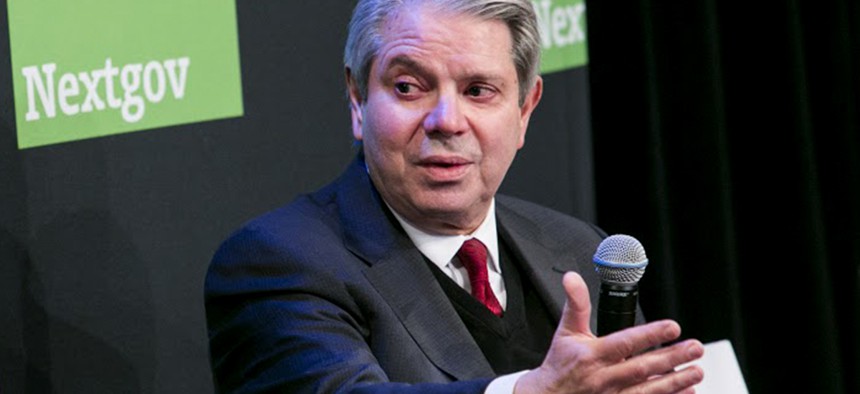Trump Doesn’t Need Silicon Valley to Eliminate Government Waste

US Comptroller General Gene Dodaro at our own event Thursday
He would do better to confer with the Government Accountability Office, the independent, nonpartisan federal agency that supports Congress to meet its constitutional responsibilities, and improves performance and ensures accountability on behalf of all Americans.
President-elect Donald Trump met with a powerful group of Silicon Valley tech executives last week to discuss ways to root out government waste.
He would do better to confer with the Government Accountability Office, the independent, nonpartisan federal agency that supports Congress to meet its constitutional responsibilities, and improves performance and ensures accountability on behalf of all Americans.
Amid the turmoil of presidential transition, with more than 4,000 political appointees to be named and additional professional turnover difficult to quantify, GAO is a rock. Only one of its 3,000-plus employees, U.S. Comptroller General Gene Dodaro, is appointed, and his 15-year term runs through 2025.
What’s more, GAO wants to help the incoming president-elect, as Dodaro explained last week at an event hosted by Nextgov.
“Under the Presidential Transition Act, GAO has a special responsibility—we’re referred to as a resource that incoming administrations are encouraged to talk to, to find out about their management challenges, risk and responsibilities,” Dodaro said. “So we take that responsibility very seriously, and we don’t wait until people to come us.”
After the election, GAO unveiled its Transition App, for example, allowing users to view a range of serious issues organized by topic and agency. New personnel within an agency can use it to get up to speed about waste, fraud, abuse and other issues plaguing their new workplace. The app boils nearly 6,000 open recommendations from GAO to roughly 10 priority recommendations per agency.
“The app was created specifically to help the incoming administration and Congress understand the issues across government,” Dodaro said.
The app also directs users to more information, including links to a management agenda concerning issues like finance and cybersecurity, and GAO’s most important product, the High Risk List.
The 2015 iteration of the list included IT acquisition and veteran health care among several dozen of the riskiest, problematic federal programs. That GAO has already identified opportunities to improve technology—an issue Trump presumably addressed with the Silicon Valley tech execs—and veteran health care—which Trump during the campaign trail often criticized the current administration of executing so poorly on—ought to catch the attention of Trump’s transition team.
Dodaro, speaking last week, said GAO will deliver its next high-risk list in February, following Trump’s inauguration. GAO will also release a report on technology, encompassing feedback from a forum Dodaro hosted on IT that included tech executives, members of Congress and other experts.
IT is actually a momentum area for GAO, with the executive branch implementing 23 percent more of approximately 800 recommendations the watchdog made in 2016 compared to 2015. In data center consolidation alone, GAO has identified upward of $8 billion in savings across agencies, or almost 10 percent of the federal IT budget.
And that’s only a drop in the bucket compared GAO’s overall work. In fiscal 2015, it identified $136.7 billion in improper payments made by programs like Medicaid. In fiscal 2016, GAO found $63.4 billion in financial benefits to taxpayers, rooting out waste, fraud and abuse, returning $112 to taxpayers for every $1 spent on the agency. GAO also identified a tidy 1,234 ways to make government more efficient.
If Trump is serious about rooting out government waste, he should spend an afternoon with GAO, rather than a room full of Silicon Valley tech executives. Or, as one columnist for Government Executive suggested recently, Trump could trade Twitter for GAO’s transition app.






